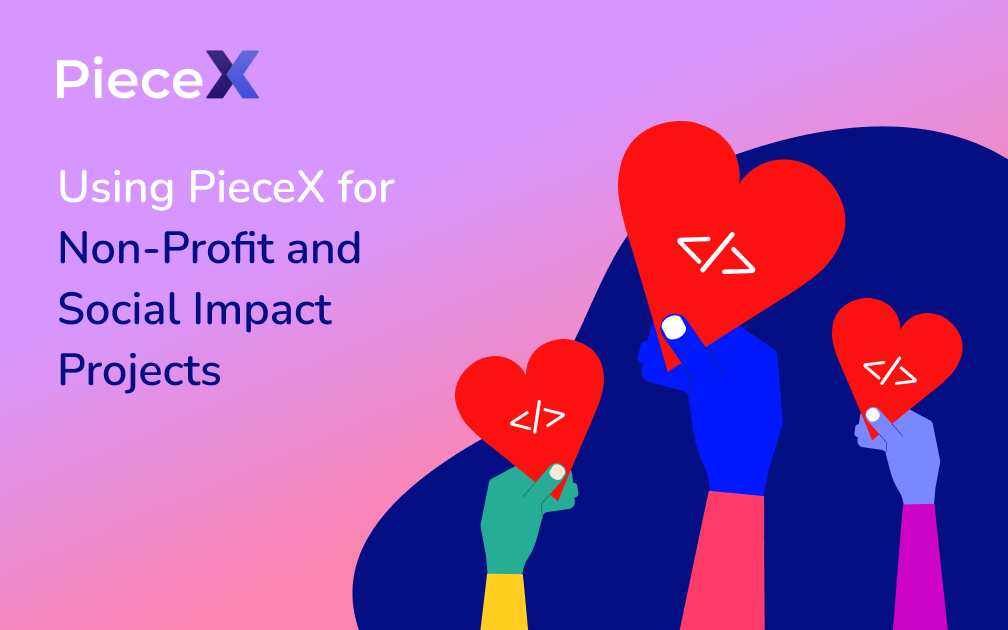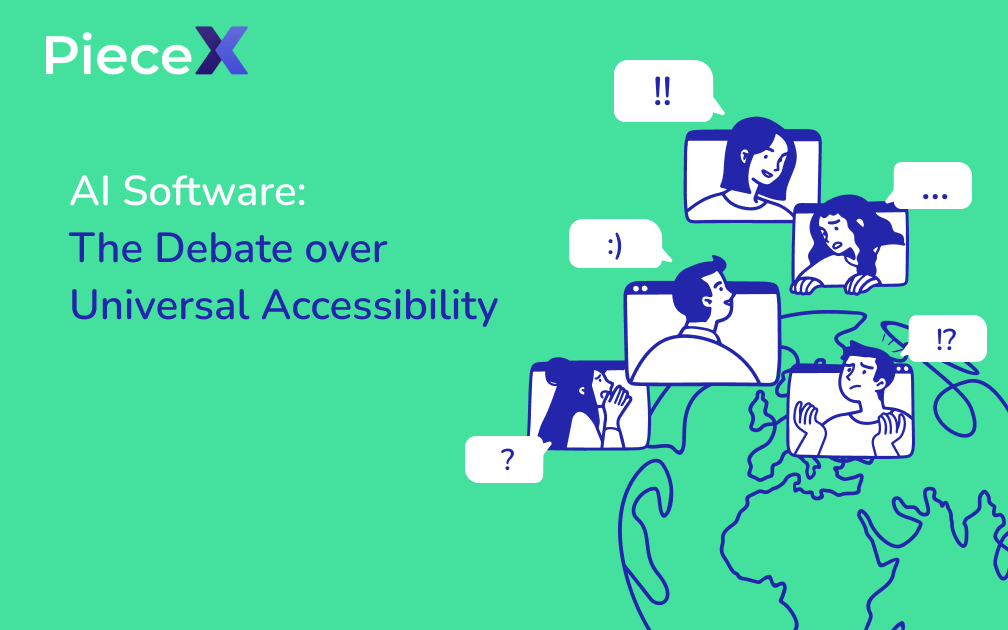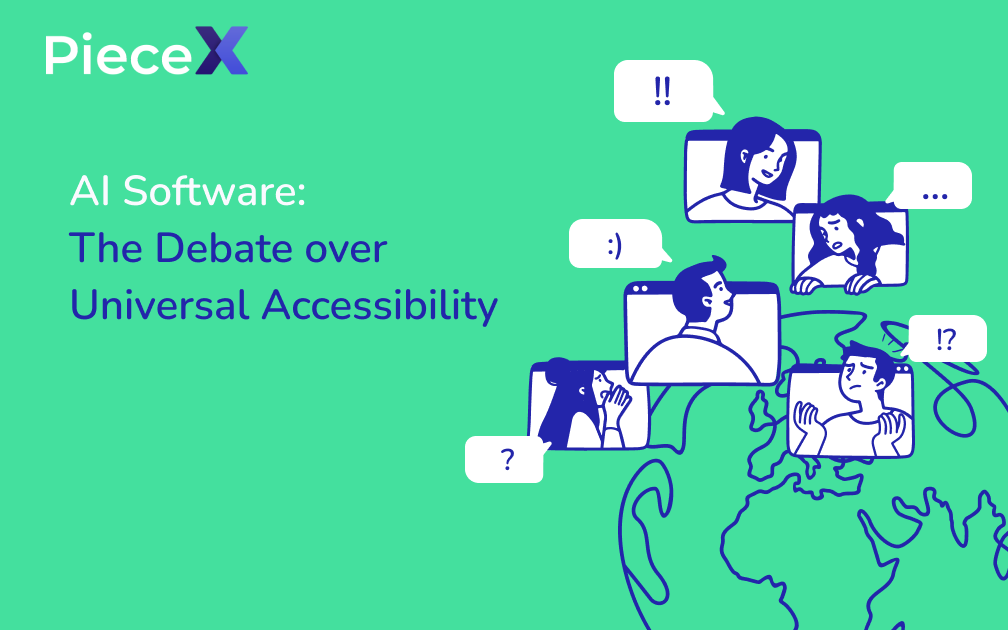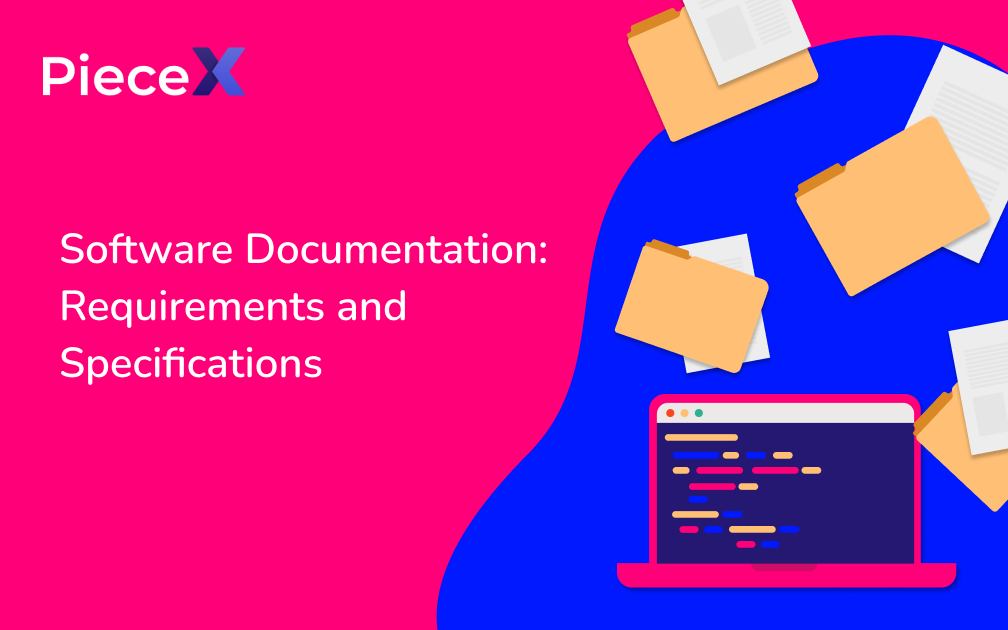

In today’s digital age, technology has the power to change lives for the better. And when it comes to non-profit and social impact projects, having the right tools can make all the difference. One such tool is PieceX, a platform that lets you source and share code. In this article, we’ll explore how PieceX can be a game-changer for non-profit and social impact initiatives.
Understanding PieceX
First things first, what exactly is PieceX? Think of it as a marketplace for code and programming resources. It’s like a treasure trove of pre-built software components, scripts, and templates created by developers from all around the world. The best part? It’s user-friendly, even for those who aren’t coding wizards.
Now, why should you care about PieceX? Well, whether you’re running a non-profit organization or working on a project with a social impact, you’ll likely need technology to support your cause. PieceX can help you find ready-made solutions, saving you time and effort.
The Importance of Non-Profit and Social Impact Projects
Non-profit and social impact projects are all about making the world a better place. They address critical issues like poverty, healthcare, education, and the environment. But these projects often lack the resources to develop custom software or applications. That’s where PieceX comes in.
By harnessing the power of technology and code, non-profit and social impact projects can reach more people, operate more efficiently, and ultimately have a greater impact on their communities.
How PieceX Supports Non-Profit and Social Impact Projects
PieceX offers a helping hand in several ways:
- Code Sharing and Collaboration: You can find and share code snippets, algorithms, and even entire projects. It’s like a global library of digital solutions.
- Access to Open-Source Resources: Many developers contribute open-source code to PieceX, which means you can use it for free. This can be a huge cost-saver for non-profit organizations with limited budgets.
- Cost-Effective Development Solutions: If you do need to hire developers, PieceX can help you find affordable experts who can customize existing code to suit your project’s needs.
Getting Started with PieceX for Non-Profit Projects
Getting started with PieceX is a breeze:
A. Sign Up: Create an account on the PieceX platform. It’s free, and you can get started in just a few minutes.
B. Navigation: Explore the platform to find the code and resources that match your project’s requirements.
C. Special Programs: Keep an eye out for special programs and discounts specifically designed for non-profit organizations. PieceX is committed to supporting social impact projects.
Challenges and Considerations
While PieceX is a valuable resource, it’s essential to be aware of potential challenges:
A. Quality Control: All code on PieceX has been pre-inspected by our Quality Assurance Team, however, Thoroughly review code insights and documentation of any code before using it.
B. Integration: Integrating code from PieceX into your project may require technical expertise. Be prepared to seek help from PieceX experts if needed.
Success Stories
PieceX has played a significant role in helping organizations and individuals achieve their non-profit and social impact goals. From creating educational apps for underserved communities to developing healthcare solutions, the possibilities are endless.
Community and Collaboration
PieceX is more than just a marketplace; it’s a community. Developers and organizations collaborate, share ideas, and support one another’s missions. Many partnerships have thrived on the platform, resulting in innovative solutions and increased impact.
Conclusion
In conclusion, PieceX can be a valuable ally for non-profit and social impact projects. It offers access to a vast library of code, connects you with developers, and fosters collaboration within a supportive community. By exploring PieceX, you can leverage technology and code to drive positive change in the world. So, why wait? Dive into PieceX and make your non-profit or social impact project a reality. Together, we can create a brighter future for all.


In the ever-evolving landscape of technology, programming languages play a vital role in enabling innovation and powering various applications. They are the building blocks that allow developers to communicate with computers and instruct them to perform specific tasks. As technology continues to influence almost every aspect of our lives, understanding the top programming languages and their applications becomes crucial for both aspiring developers and businesses seeking the right tools to achieve their goals.
This article will delve into five of the most popular and versatile programming languages used today: Python, JavaScript, Java, C++, and SQL. We will explore their key features, strengths, and real-world applications in different domains.
Python
Introduction to Python and its key features
Python, known for its simplicity and readability, has gained immense popularity among developers worldwide. Its user-friendly syntax allows programmers to write clear and concise code, making it an excellent choice for both beginners and experienced developers. Moreover, Python’s versatility and extensive library support contribute to its widespread adoption.
Applications of Python in various domains
Web development and frameworks (e.g., Django, Flask): Python’s web development frameworks like Django and Flask facilitate the creation of robust and scalable web applications with ease.
Data science and analytics (e.g., Pandas, NumPy): Python’s libraries, such as Pandas and NumPy, provide powerful tools for data manipulation, analysis, and visualization.
Machine learning and artificial intelligence (e.g., TensorFlow, PyTorch): Python’s simplicity and the availability of libraries like TensorFlow and PyTorch make it a preferred language for AI and ML projects.
Scripting and automation: Python’s scripting capabilities are valuable for automating repetitive tasks, simplifying workflows, and enhancing productivity.
Real-world examples of Python usage
Major companies like Google, Facebook, and Netflix utilize Python for various purposes. For instance, Google relies on Python for system administration tasks, while Facebook employs it for managing their infrastructure. Netflix uses Python to handle numerous aspects of their content delivery platform.
JavaScript
Introduction to JavaScript and its significance
JavaScript is the backbone of interactive web development, enabling dynamic and responsive user interfaces. As a client-side language, it runs directly in the user’s browser, enhancing website interactivity and user experience.
Applications of JavaScript in different contexts
Front-end web development (e.g., React, Angular, Vue.js): JavaScript powers popular front-end frameworks like React, Angular, and Vue.js, enhancing the interactivity of web applications.
Back-end development (e.g., Node.js): With the advent of Node.js, JavaScript has extended its reach to the server-side, allowing developers to build real-time and scalable applications.
Building mobile applications (e.g., React Native, NativeScript): JavaScript’s frameworks, such as React Native and NativeScript, enable cross-platform mobile app development.
Game development (e.g., Phaser, Unity): JavaScript, coupled with game development frameworks like Phaser and Unity, facilitates the creation of engaging browser and mobile games.
Demonstrations of JavaScript applications
JavaScript’s widespread usage is evident across various websites, web applications, and mobile apps. Platforms like Airbnb and Netflix utilize React to enhance their user interfaces, while PayPal employs Node.js to handle millions of transactions efficiently.
Java
Introduction to Java and its characteristics
Java, renowned for its platform independence and robustness, remains a favorite among enterprise-level applications and large-scale projects.
Applications of Java in diverse industries
Enterprise-level applications and server-side development: Java’s scalability and stability make it a top choice for building enterprise-level systems and server-side applications.
Android mobile app development: Java serves as the primary language for developing Android applications, enabling developers to create feature-rich and secure mobile apps.
Big data processing (e.g., Hadoop, Spark): Java is integral to big data processing frameworks like Hadoop and Spark, handling vast amounts of data efficiently.
Internet of Things (IoT) development: Java’s versatility extends to IoT development, enabling the creation of connected and smart devices.
Case studies highlighting Java’s versatility
Major financial institutions like Goldman Sachs and Barclays utilize Java for their banking systems, showcasing its reliability and suitability for handling critical transactions.
C++
Introduction to C++ and its key strengths
C++ is a powerful and efficient language, often preferred for low-level programming and resource-intensive applications.
Applications of C++ in critical domains
Systems programming and operating systems: C++ is commonly used for developing operating systems and system-level software due to its direct memory manipulation capabilities.
Game development (e.g., Unreal Engine): C++ forms the backbone of game development engines like Unreal Engine, enabling the creation of high-quality and performance-intensive games.
High-performance applications (e.g., image and video processing): C++’s low-level control and speed make it ideal for tasks like image and video processing.
Embedded systems and hardware programming: C++ is frequently used in embedded systems and hardware programming, where efficiency and direct hardware access are paramount.
Real-world examples of C++ usage
Adobe’s suite of creative applications, including Photoshop and Illustrator, rely on C++ for their underlying architecture, highlighting its significance in performance-critical software.
SQL (Structured Query Language)
Introduction to SQL and its role in database management
SQL is the standard language for interacting with relational databases, enabling efficient data storage, retrieval, and manipulation.
Applications of SQL in data-centric industries
Relational database management systems (e.g., MySQL, PostgreSQL): SQL is utilized in popular database systems like MySQL and PostgreSQL, which power countless web applications and services.
Data manipulation and querying: SQL’s capabilities in handling complex data operations make it invaluable for extracting valuable insights from large datasets.
Business intelligence and data analysis: SQL is an essential tool for business intelligence and data analysts who rely on it to generate reports and make data-driven decisions.
Data-driven decision-making processes: SQL facilitates data-driven decision-making by providing access to accurate and relevant information.
Illustrations of SQL in action
Many organizations, such as Amazon, eBay, and Airbnb, use SQL to manage vast amounts of transactional data and provide personalized user experiences.
Recap of the top 5 programming languages and their applications
In this article, we explored the top 5 programming languages and their diverse applications across various industries and domains. Python shines in web development, data science, and AI, while JavaScript powers interactive web applications and mobile apps. Java’s versatility makes it suitable for enterprise systems, mobile app development, big data, and IoT. C++ excels in systems programming, game development, and resource-intensive applications, while SQL is crucial for efficient database management and data-driven decision-making.
When selecting a programming language for a project, factors such as project requirements, performance needs, team expertise, and community support should be carefully considered.
Conclusion
In conclusion, understanding the strengths and applications of various programming languages is crucial for developers and businesses alike. Each language brings its unique capabilities to the table, and selecting the right one can significantly impact the success of a project.
As technology evolves, so do programming languages. New languages and frameworks may emerge, offering novel solutions to address specific challenges. Developers must stay updated with the latest trends to remain competitive and innovative in their respective fields.
Each language brings its unique strengths and applications, and understanding their capabilities empowers developers to make informed choices for their projects. In the ever-changing landscape of technology, programming languages will continue to play a vital role in shaping the future of innovation and driving progress in modern technology. Whether it’s building web applications, harnessing the power of artificial intelligence, managing large datasets, or developing performance-intensive systems, the right programming language can unlock endless possibilities and propel technology to new heights.
For more articles such as this, make sure to visit the PieceX Knowledgebase blog.


Artificial Intelligence (AI) has emerged as a transformative force in the modern world, reshaping industries, economies, and societies. As AI technology becomes more prevalent, a crucial question arises: should AI software be available to everyone? This article delves into the pros and cons of universal access to AI software, exploring its potential advantages, challenges, perspectives on regulation, addressing biases, and the future of AI accessibility.
AI software refers to computer programs and algorithms that enable machines to perform tasks that typically require human intelligence. These tasks can include problem-solving, decision-making, language processing, image recognition, and much more. AI technology ranges from simple rule-based systems to sophisticated neural networks that learn from vast datasets.
The Advantages of Universal AI Software Accessibility
A. Democratizing Technology: Bridging the Digital Divide
Universal access to AI software can help bridge the digital divide by providing equitable opportunities to individuals and communities with limited access to advanced technologies. By making AI tools and resources accessible, underserved regions can leapfrog into the digital era, improving education, healthcare, and economic prospects.
B. Fostering Innovation and Creativity
When AI software becomes widely available, it empowers innovators and entrepreneurs from diverse backgrounds to experiment and create groundbreaking applications. Lowering barriers to entry encourages a broader range of ideas, leading to innovative solutions for global challenges.
C. Empowering Individuals and Small Businesses
Universal AI access offers individual users and small businesses the ability to harness AI technology to enhance productivity and decision-making. From automating repetitive tasks to personalized marketing, AI tools can level the playing field and boost efficiency for enterprises of all sizes.
D. Potential for Societal Transformation and Problem Solving
Universal AI software can accelerate research and problem-solving efforts in various fields, such as healthcare, climate change, and disaster response. AI-powered analysis of vast datasets allows for better understanding and more effective solutions to complex issues.
IThe Challenges of Universal AI Software Accessibility
A. Ethical Concerns: AI Misuse and Weaponization
Universal access to AI software raises concerns about potential misuse, including the development of autonomous weapons, deepfake technology, and AI-generated misinformation. Addressing ethical issues becomes paramount to ensure that AI is used responsibly and does not harm humanity.
B. Security Risks and Data Privacy Issues
Widespread availability of AI software also heightens security risks, as cybercriminals may exploit AI algorithms to breach sensitive systems. Additionally, AI applications often require access to vast amounts of personal data, posing significant privacy challenges that demand stringent safeguards.
C. Widening Socioeconomic Disparities
While universal AI access has the potential to narrow disparities, it can also exacerbate existing inequalities. Those with limited resources or education may struggle to fully utilize AI technology, creating a new form of digital divide based on AI literacy.
D. Impact on Employment and Labor Market
The widespread adoption of AI could disrupt industries and displace certain jobs. While AI has the potential to create new employment opportunities, there is a need for measures to retrain and reskill workers affected by automation.
Perspectives on Regulation and Control
A. Striking a Balance: Ensuring Responsible AI Use
Striking a balance between open access and responsible use is essential. Governments and organizations must implement regulations that promote ethical AI development and usage while encouraging innovation and access.
B. Importance of Ethical Guidelines and Standards
Establishing clear ethical guidelines and standards for AI development and deployment is crucial. This can help prevent AI systems from being used for malicious purposes and ensure they align with societal values.
C. Collaboration between Governments, Corporations, and Civil Society
Addressing the challenges of universal AI access requires collaboration between governments, corporations, and civil society. Open dialogue and cooperation can lead to more comprehensive and effective AI policies.
D. AI Software Licensing and Open-Source Alternatives
Exploring various licensing models, such as open-source AI software, can foster a collaborative environment, encouraging developers worldwide to contribute to AI advancement.
Addressing AI Bias and Fairness
A. Understanding Bias in AI Algorithms
AI algorithms can perpetuate existing biases present in training data, leading to unfair or discriminatory outcomes. Recognizing and understanding these biases is crucial in addressing them effectively.
B. Mitigation Strategies and Algorithmic Transparency
Developing strategies to mitigate AI bias and ensuring algorithmic transparency can help build trust in AI systems and promote fairness in their application.
C. Promoting Diversity in AI Development
Diverse perspectives in AI development teams can lead to more inclusive and unbiased AI technologies. Encouraging diversity in the AI field is essential for creating ethical and accessible AI solutions.
The Future of AI Accessibility: Limitations and Possibilities
A. Assessing Technological Readiness and Infrastructure
The universal accessibility of AI software depends on technological readiness and infrastructure. Improving internet connectivity and computing capabilities in underserved areas is crucial for equitable access.
B. Forecasting AI Development and Adoption
Anticipating the future growth of AI technology and its applications can inform policymakers and stakeholders to make informed decisions.
C. AI in Education and Raising AI Awareness
Promoting AI education and awareness is vital for preparing individuals to use AI responsibly and understand its societal impact.
Conclusion
AI software’s universal accessibility presents both promise and challenges. It can democratize technology, fuel innovation, and transform societies. However, ethical concerns, data privacy issues, and potential socioeconomic disparities demand careful regulation and responsible AI use. By addressing AI bias, fostering collaboration, and promoting inclusive development, we can shape a future where AI benefits all of humanity. The role of governments, corporations, and individuals in ensuring inclusive AI development is critical, as we navigate the debate over universal AI accessibility and chart a path towards a more equitable AI-powered world.
For more articles such as this, make sure to visit the PieceX Knowledgebase Blog.


Welcome to the wonderful world of software documentation, where clarity meets creativity, and precision blends with playfulness. In this article, we will embark on an exciting journey to explore the ins and outs of software documentation. Buckle up as we delve into the importance, types, best practices, and tools that make software documentation an indispensable aspect of every successful software development project.
Software documentation is the holy grail that brings order to the complex realm of software development. It encompasses a wide range of materials designed to facilitate understanding, communication, and collaboration among stakeholders. User documentation, technical documentation, and system documentation are the three key categories that shape this fascinating domain.
User documentation, our trusty guide, helps users navigate through software applications effortlessly. It includes user manuals, tutorials, FAQs, and any material that helps users get the most out of the software.
Technical documentation, on the other hand, caters to developers and engineers. It comprises APIs, SDKs, code samples, and in-depth technical guides.
Lastly, system documentation paints the big picture by documenting the architecture, workflows, and integrations of the software.
Software Requirements: The Building Blocks
Imagine constructing a magnificent skyscraper without a blueprint. Software development without requirements is no different. Software requirements define what the software should do, and they play a vital role in shaping its functionality. Gathering requirements involves close collaboration between developers, clients, and end-users to ensure the software meets their needs.
Functional requirements outline the software’s core functionalities and user interactions. Non-functional requirements, on the other hand, focus on the software’s performance, security, and other quality attributes.
To document requirements effectively, clear and concise writing is crucial. By utilizing the power of language and context, requirements can be expressed in a manner that eliminates ambiguity and confusion.
Software Specifications
If requirements are the foundation, specifications are the intricate details that bring a software system to life. Specifications dig deeper into the implementation details, outlining design, performance, and interface requirements.
Design specifications provide a blueprint for the software’s internal workings, defining the structure, modules, and algorithms that make it tick.
Performance specifications set the performance benchmarks, ensuring the software operates within acceptable speed and resource limits.
Interface specifications govern how the software communicates with external systems or components, establishing protocols and data formats.
To write effective specifications, one must clearly communicate the technical aspects while considering the needs and perspectives of various stakeholders. Bridging the gap between technical jargon and plain language helps foster a common understanding among team members.
Documenting Software Changes and Updates
In the ever-evolving landscape of software development, change is inevitable. Documenting changes and updates is not only important for maintaining clarity but also for ensuring the smooth evolution of the software. Change management processes provide a structured approach to handle modifications, involving proper documentation of the changes, their impact, and associated risks.
Version control and user documentation tracking tools help manage the various iterations of the software and its accompanying documentation. By maintaining accurate and up-to-date records, teams can effectively track changes, understand the evolution of the software, and revert to previous versions if needed.
In the realm of software documentation, technology acts as a trusted ally. Various documentation tools and technologies simplify the process, enabling teams to create, manage, and collaborate on documentation efficiently. Choosing the right tools depends on the specific requirements of the project, considering factors such as ease of use, collaboration features, and integration capabilities.
Best practices are the guiding principles that help create documentation that is clear, organized, and engaging. A well-structured document ensures easy navigation and comprehension, while the inclusion of diagrams, visuals, and examples adds a touch of liveliness to the content. Regular reviews and updates keep documentation relevant and accurate, ensuring it remains a valuable asset throughout the software development lifecycle to result in successful software development.
Conclusion
As we bid farewell to our exploration of software documentation, we are reminded of its paramount importance in the world of software development. Through user documentation, technical documentation, and system documentation, we empower users, guide developers, and provide a holistic view of software systems.
By understanding the significance of requirements, specifications, and the art of change management, we lay the groundwork for successful software development projects. Armed with the right tools and best practices, we unlock the true potential of successful software development, fostering collaboration, clarity, and innovation.
So, dear readers, let us embark on our software development journeys with a renewed commitment to prioritize software documentation. Let us ensure that the foundation is solid, the details are vivid, and the changes are documented. With software documentation as our guiding star, we shall conquer the realms of software development with confidence and ease.
For more articles such as this, make sure to check out our PieceX Knowledgebase Blog.


When it comes to building a website, there are numerous factors to consider. From content creation to technical aspects, every element plays a crucial role in delivering a seamless user experience. One such vital element is the User Interface (UI).
UI refers to the visual and interactive aspects of a website that users interact with. In simple terms, it’s the design and layout that make your website visually appealing and user-friendly. In this article, we will explore the importance of UI in website development and provide insights on how to improve your website’s UI to create an engaging and user-centric online platform.
How To Improve Your Website UI
To begin with, it’s essential to have a dedicated UI team that can thoroughly analyze and optimize your website’s interface. They will pay attention to every detail and ensure that the UI aligns with your brand image and target audience. Additionally, you can explore online platforms like PieceX, which offer a wide range of UI designs and website templates. These resources can serve as a starting point or inspiration to enhance your website’s UI.
Creating a Positive User Experience
A crucial aspect of UI is creating a positive user experience. To achieve this, your website should have an intuitive and user-friendly interface. Users should be able to navigate through your website effortlessly and find the information they need. It’s important to have clear and well-organized navigational elements and a logical structure. By maintaining consistency in design and branding across your website, users will feel more comfortable and familiar with your interface, leading to a more enjoyable experience.
Enhancing Usability
Usability is another key aspect influenced by UI. Your website should provide clear and concise information, avoiding clutter that can confuse or overwhelm visitors. Additionally, optimizing your website’s responsiveness and performance is crucial. Slow-loading pages or unresponsive elements can frustrate users and drive them away. By incorporating accessibility features such as alt tags for images and keyboard navigation options, you can ensure that your website is usable by a broader range of individuals, including those with disabilities.
Establishing Credibility and Trust
A visually appealing UI helps establish credibility and trust with your audience. Using appropriate color schemes and typography that align with your brand identity can create a sense of professionalism. Additionally, incorporating relevant visual elements and multimedia, such as high-quality images or videos, can enhance engagement and make your website more appealing. Effective use of white space can also provide a clean and organized look, making it easier for users to focus on your content.
Increasing User Engagement
Engaging users is essential for the success of your website. By utilizing interactive elements and animations, you can add an element of interactivity that captivates visitors’ attention and encourages them to explore further. Implementing intuitive forms and prominent calls to action can guide users towards desired actions, such as making a purchase or subscribing to a newsletter. Additionally, incorporating social sharing and feedback mechanisms can encourage users to interact with your website and share their experiences, leading to increased engagement and brand awareness.
Mobile-Friendly Design
In today’s mobile-centric world, having a mobile-friendly design is crucial. With an increasing number of users accessing websites from their smartphones and tablets, it’s essential to prioritize responsive design. A responsive design ensures that your website adapts and displays correctly on various screen sizes and devices. By considering design considerations for smaller screens, such as optimizing font sizes and button placements, you can provide a seamless experience for mobile users. Taking a mobile-first approach, where you prioritize designing for mobile devices and then scale up for desktops, can also lead to better overall user experience.
Optimizing Conversion Rates
The ultimate goal of any website is to convert visitors into customers or achieve specific goals. UI plays a significant role in optimizing conversion rates. By strategically designing your UI, you can guide users towards desired actions, such as making a purchase or filling out a contact form. A/B testing and user feedback are valuable tools for UI optimization. By analyzing and testing different UI elements, you can identify what works best for your audience and make data-driven improvements to increase conversion rates.
Conclusion
In conclusion, the User Interface (UI) is a crucial aspect of website development that should not be overlooked. A well-designed and user-friendly UI creates a positive user experience, enhances usability, establishes credibility and trust, increases user engagement, and optimizes conversion rates. By investing time and effort into improving your website’s UI, you can create an effective online platform that attracts and retains visitors, ultimately leading to the achievement of your goals. Remember, UI is not just about aesthetics but also about delivering a seamless and enjoyable experience for your users. So, embrace the power of UI and take your website to new heights.
For more articles like this, make sure to visit our knoweldgebase blog.








